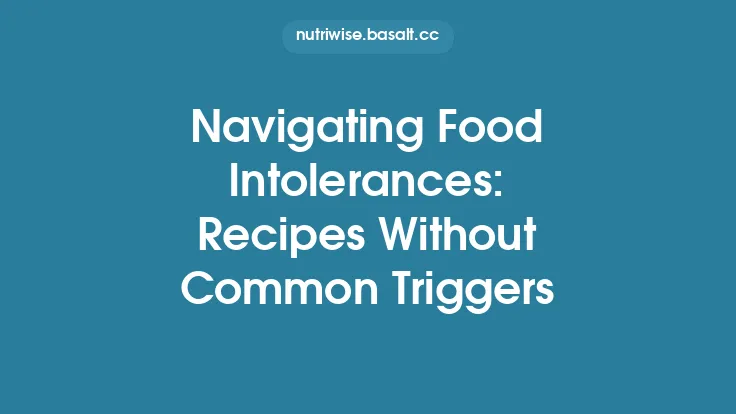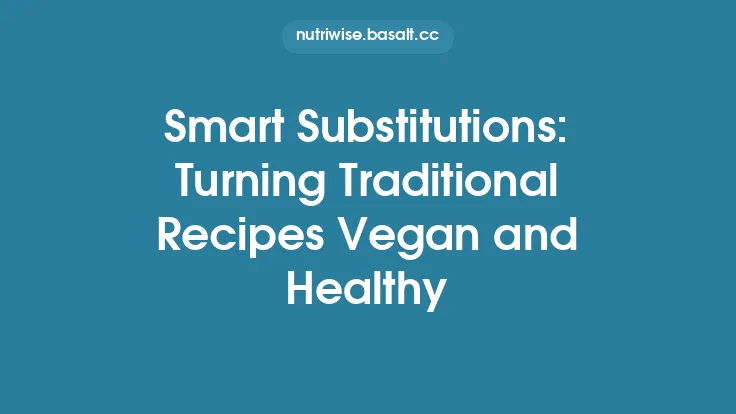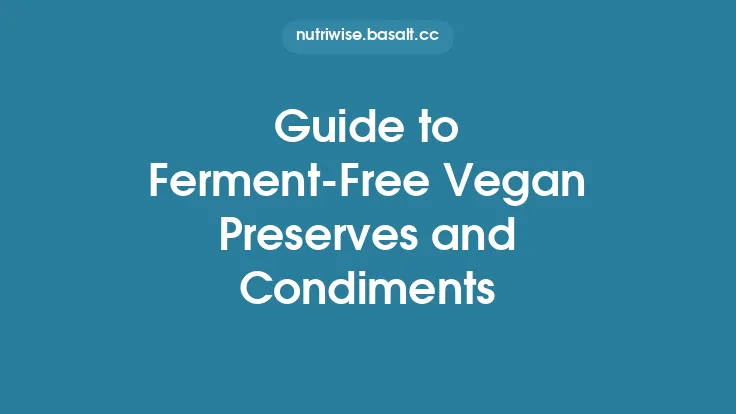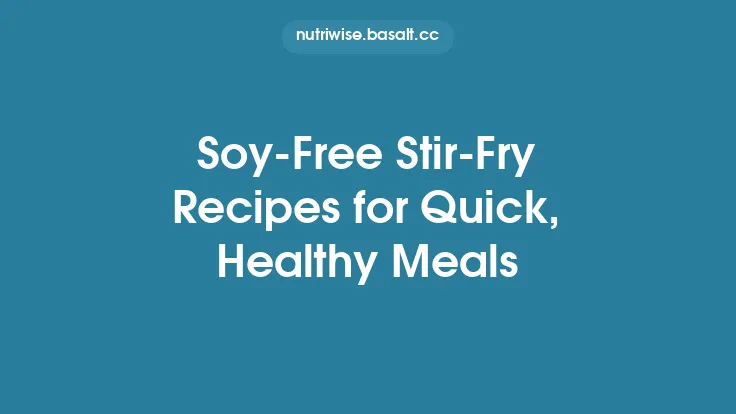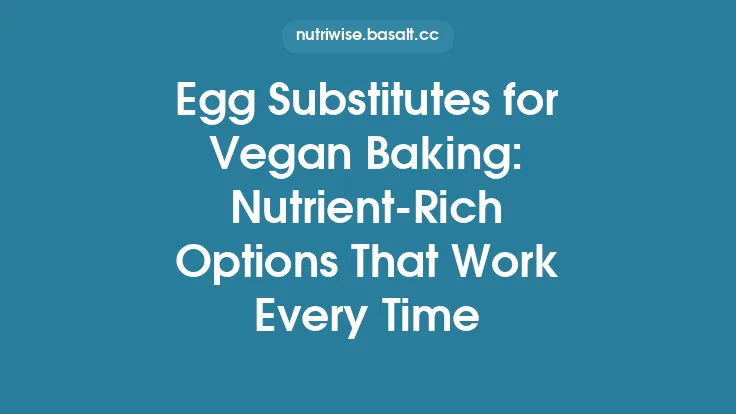Vasting the world of vegan cooking can feel like navigating a maze of ingredient lists, especially when you’re also trying to steer clear of the most common food allergens. Whether you’re newly diagnosed with a food allergy, cooking for a loved one with multiple sensitivities, or simply looking to broaden your culinary repertoire, the good news is that a vibrant, satisfying vegan diet can be built without relying on gluten, soy, nuts, dairy, eggs, sesame, or other typical triggers. This guide walks you through the foundational concepts, pantry staples, and step‑by‑step recipes that make allergen‑free vegan cooking both approachable and delicious.
Understanding Common Food Allergens in Vegan Cooking
Allergen awareness begins with knowing which ingredients are most likely to cause reactions. In the vegan sphere, the usual suspects include:
| Allergen | Typical Vegan Sources | Why It’s Problematic |
|---|---|---|
| Gluten | Wheat, barley, rye, spelt, seitan, many processed sauces | Triggers celiac disease and non‑celiac gluten sensitivity. |
| Soy | Tofu, tempeh, soy milk, soy sauce, miso, edamame | One of the “big eight” allergens; can be hidden in processed foods. |
| Tree Nuts & Peanuts | Almonds, cashews, walnuts, peanuts, nut‑based milks, butters | Can cause severe anaphylaxis; often used as texture enhancers. |
| Dairy | Vegan “cheeses,” yogurts, and creams made from dairy derivatives | Even trace dairy can be problematic for those with lactose intolerance or dairy allergy. |
| Eggs | Vegan egg replacers (often derived from soy or peas) | Egg proteins are a common trigger; many commercial replacers contain soy. |
| Sesame | Tahini, sesame oil, sesame seeds, some hummus varieties | Rising in prevalence as an allergen, especially in Middle‑Eastern cuisines. |
| Mustard | Mustard seeds, mustard powder, many vinaigrettes | Frequently used in dressings and sauces. |
| Sulfites | Dried fruits, wine, some canned vegetables | Can provoke asthma and other reactions. |
Understanding where these allergens hide—especially in processed or “ready‑to‑eat” items—helps you read labels more effectively and avoid accidental exposure.
Core Principles for Allergen‑Free Vegan Meal Planning
- Start with Whole Foods
Fresh vegetables, fruits, legumes, whole grains (e.g., rice, millet, sorghum), and tubers are naturally free of the major allergens listed above. Building meals around these staples reduces reliance on processed products that may contain hidden triggers.
- Prioritize Protein Diversity
Without soy, beans, lentils, peas, and certain grains become the primary protein sources. Combine complementary proteins (e.g., rice + beans) to ensure a complete amino acid profile.
- Mind Micronutrients
Vegan diets can be low in vitamin B12, vitamin D, iodine, calcium, iron, and omega‑3 fatty acids. Choose fortified products (e.g., B12‑fortified oat milk) that are also allergen‑free, or supplement as needed.
- Batch Cook and Freeze
Preparing large quantities of base components—such as cooked beans, roasted vegetables, and grain salads—allows you to assemble meals quickly while maintaining strict allergen control.
- Create a “Safe Zone” Kitchen
Designate specific utensils, cutting boards, and storage containers for allergen‑free cooking. Clean surfaces thoroughly between tasks to prevent cross‑contamination.
Building a Nutrient‑Rich Allergen‑Free Vegan Pantry
| Category | Recommended Items | Usage Tips |
|---|---|---|
| Grains & Pseudograins | White rice, brown rice, millet, sorghum, teff, quinoa (if tolerated) | Rinse grains before cooking to remove residual saponins; store in airtight containers. |
| Legumes | Red lentils, green lentils, split peas, black beans, chickpeas, mung beans | Soak beans overnight to reduce cooking time and improve digestibility. |
| Root Vegetables & Tubers | Sweet potatoes, regular potatoes, carrots, beets, parsnips | Roast for natural sweetness; mash for creamy sauces. |
| Fats & Oils | Extra‑virgin olive oil, avocado oil, coconut oil, cold‑pressed sunflower oil | Use oils with high smoke points for sautéing; coconut milk for richness. |
| Flavor Builders | Fresh herbs (parsley, cilantro, thyme, rosemary), dried spices (cumin, smoked paprika, turmeric), garlic, ginger, onion powder, nutritional yeast (check for sulfite content) | Toast spices briefly to unlock deeper flavors. |
| Acidic Elements | Apple cider vinegar, lemon juice, lime juice, tamarind paste (sulfite‑free) | Balance richness and add brightness to sauces. |
| Thickening Agents | Arrowroot powder, tapioca starch, cornstarch (if corn is tolerated) | Mix with cold water before adding to hot liquids to avoid clumping. |
| Sweeteners | Maple syrup, agave nectar, date paste | Use sparingly in desserts or sauces. |
| Fortified Beverages | Oat milk, rice milk, hemp milk fortified with calcium, vitamin D, and B12 (ensure no added soy or nuts) | Great for soups, sauces, and smoothies. |
Recipe Collection: Allergen‑Free Vegan Dishes
Below are five fully vegan, allergen‑free recipes that showcase a range of flavors and textures. Each recipe includes ingredient notes to help you adapt for additional sensitivities.
Hearty Lentil & Vegetable Stew
Servings: 6 | Prep: 15 min | Cook: 45 min
Ingredients
- 1 cup red lentils, rinsed
- 2 tbsp olive oil
- 1 large onion, diced
- 2 carrots, sliced into ½‑inch rounds
- 2 celery stalks, diced
- 3 cloves garlic, minced
- 1 tsp ground cumin
- 1 tsp smoked paprika
- 1 tsp dried thyme
- 4 cups low‑sodium vegetable broth (check label for soy‑free)
- 1 cup diced tomatoes (canned, no added sugar)
- 2 medium potatoes, cubed
- Salt & pepper to taste
- Fresh parsley, chopped (for garnish)
Method
- Heat olive oil in a large pot over medium heat. Add onion, carrots, and celery; sauté until softened, about 5 minutes.
- Stir in garlic, cumin, smoked paprika, and thyme; cook for 1 minute until fragrant.
- Add lentils, broth, tomatoes, and potatoes. Bring to a boil, then reduce heat to a simmer.
- Cover and cook for 30‑35 minutes, or until lentils and potatoes are tender.
- Season with salt and pepper. Serve hot, garnished with fresh parsley.
Allergen Note: This stew is naturally free of gluten, soy, nuts, dairy, and sesame. Ensure the broth you choose does not contain hidden soy or wheat additives.
Creamy Coconut Chickpea Curry
Servings: 4 | Prep: 10 min | Cook: 25 min
Ingredients
- 1 tbsp coconut oil
- 1 medium onion, finely chopped
- 2 cloves garlic, minced
- 1 tbsp fresh ginger, grated
- 1 tbsp curry powder (ensure no added mustard)
- 1 tsp ground coriander
- 1 tsp turmeric
- 1 can (14 oz) chickpeas, drained and rinsed
- 1 can (13.5 oz) full‑fat coconut milk
- 1 cup diced butternut squash or sweet potato
- 1 cup frozen peas (optional)
- Salt to taste
- Fresh cilantro, chopped (for garnish)
- Cooked rice or millet, for serving
Method
- In a saucepan, melt coconut oil over medium heat. Add onion and sauté until translucent, about 4 minutes.
- Add garlic, ginger, curry powder, coriander, and turmeric; stir for 1 minute.
- Pour in coconut milk, then add chickpeas and diced squash. Bring to a gentle boil, then reduce to a simmer.
- Cook for 15‑20 minutes, or until the squash is tender and the sauce has thickened.
- Stir in frozen peas (if using) and heat through. Season with salt.
- Serve over rice or millet, garnished with cilantro.
Allergen Note: Coconut milk provides richness without dairy. Verify that the curry powder does not contain mustard or soy flour.
Sweet Potato & Black Bean Tacos (Corn‑Tortilla Free)
Servings: 4 | Prep: 15 min | Cook: 20 min
Ingredients
- 2 medium sweet potatoes, peeled and diced
- 1 tbsp avocado oil
- 1 tsp smoked paprika
- ½ tsp ground cumin
- Salt & pepper to taste
- 1 can (15 oz) black beans, drained and rinsed
- 1 cup shredded red cabbage
- ½ cup diced mango or pineapple (optional)
- ¼ cup chopped fresh cilantro
- Juice of 1 lime
- 8 large lettuce leaves (for “wraps”) or gluten‑free corn tortillas (check for cross‑contamination)
Method
- Preheat oven to 400 °F (200 °C). Toss sweet potato cubes with avocado oil, smoked paprika, cumin, salt, and pepper. Spread on a baking sheet and roast for 20 minutes, turning halfway through.
- While sweet potatoes roast, warm black beans in a small saucepan over low heat.
- Assemble tacos: place a lettuce leaf (or tortilla) on a plate, add a spoonful of roasted sweet potatoes, black beans, shredded cabbage, mango/pineapple, and a drizzle of lime juice. Top with cilantro.
- Serve immediately.
Allergen Note: This recipe avoids gluten, soy, nuts, dairy, and sesame. If using corn tortillas, ensure they are certified gluten‑free and processed in a nut‑free facility.
Baked Apple Crumble (Dessert)
Servings: 6 | Prep: 15 min | Cook: 35 min
Ingredients
- 5 medium apples, peeled, cored, and sliced
- 2 tbsp lemon juice
- ¼ cup maple syrup
- 1 tsp ground cinnamon
- ½ tsp ground nutmeg
- Crumble Topping:
- ¾ cup rolled oats (gluten‑free certified)
- ¼ cup coconut flour
- ¼ cup coconut sugar or brown sugar (if tolerated)
- ¼ cup coconut oil, solid but scoopable
- Pinch of salt
Method
- Preheat oven to 375 °F (190 °C). Toss apple slices with lemon juice, maple syrup, cinnamon, and nutmeg. Transfer to a greased 9‑inch baking dish.
- In a bowl, combine rolled oats, coconut flour, coconut sugar, and salt. Add solid coconut oil and rub between fingertips until the mixture resembles coarse crumbs.
- Evenly sprinkle the crumble topping over the apples.
- Bake for 30‑35 minutes, until the topping is golden and the apples are bubbling.
- Allow to cool slightly before serving. Optional: serve with a scoop of allergen‑free vanilla ice cream (e.g., oat‑milk based).
Allergen Note: This dessert is free of gluten, soy, nuts, dairy, and eggs. Verify that the rolled oats are certified gluten‑free to avoid cross‑contamination.
Quinoa‑Free Grain Bowl with Buckwheat & Roasted Veggies
*(While buckwheat is technically a pseudocereal, it is naturally gluten‑free and offers a nutty flavor that works well in grain bowls.)*
Servings: 4 | Prep: 15 min | Cook: 25 min
Ingredients
- 1 cup buckwheat groats, rinsed
- 2 cups water or low‑sodium vegetable broth (check for soy)
- 1 tbsp olive oil
- 1 red bell pepper, sliced
- 1 zucchini, sliced into half‑moons
- 1 cup broccoli florets
- 1 tsp dried oregano
- Salt & pepper to taste
- ¼ cup toasted pumpkin seeds (optional, omit if seed allergy)
- Dressing: 2 tbsp tahini‑free sunflower seed butter, 1 tbsp apple cider vinegar, 1 tbsp maple syrup, 2 tbsp water, pinch of smoked paprika
Method
- In a saucepan, bring water or broth to a boil. Add buckwheat, reduce heat, cover, and simmer for 15‑20 minutes, until tender and liquid is absorbed. Fluff with a fork.
- Meanwhile, preheat oven to 425 °F (220 °C). Toss bell pepper, zucchini, and broccoli with olive oil, oregano, salt, and pepper. Roast for 15‑20 minutes, stirring halfway.
- Whisk together dressing ingredients until smooth. Adjust thickness with extra water if needed.
- Assemble bowls: start with a base of buckwheat, top with roasted vegetables, sprinkle pumpkin seeds (if using), and drizzle dressing.
Allergen Note: This bowl avoids gluten, soy, nuts, dairy, and sesame. If pumpkin seeds are a concern, replace with roasted chickpeas for crunch.
Customizing Recipes for Multiple Allergens
Allergen profiles can vary widely from person to person. Here are practical strategies to adapt the recipes above:
| Challenge | Adaptation Technique |
|---|---|
| Both soy and sesame are off‑limits | Use soy‑free tamari alternatives (e.g., coconut‑amino) and replace tahini‑based dressings with sunflower seed butter or avocado‑based sauces. |
| Nut allergy plus seed allergy | Omit pumpkin seeds and replace with toasted oat flakes or crispy roasted chickpeas for texture. |
| Gluten and corn sensitivities | Stick to certified gluten‑free grains (rice, millet, sorghum) and avoid corn‑based tortillas; use lettuce wraps or rice paper. |
| Low‑FODMAP needs | Reduce onion and garlic; use the green parts of scallions and garlic‑infused oil for flavor without the fermentable carbs. |
| Limited access to fortified milks | Supplement B12 and vitamin D directly, and use calcium‑rich foods like fortified tofu (if soy is tolerated) or calcium‑rich leafy greens (kale, bok choy). |
When swapping ingredients, keep the following in mind:
- Flavor Balance: If you replace a nut‑based butter with a seed butter, you may need to adjust salt or acidity to maintain the same depth.
- Texture: Seeds and nuts often provide crunch; consider toasted legumes (e.g., roasted chickpeas) or crisped rice for a similar bite.
- Cooking Time: Some substitutes (e.g., lentils vs. beans) have different cooking durations; plan accordingly.
Food Safety, Cross‑Contamination, and Label Reading
- Designate Allergen‑Free Zones – Keep a separate set of cutting boards, knives, and storage containers for allergen‑free foods. Label them clearly.
- Sanitize Surfaces – After preparing an allergen‑containing ingredient, wash surfaces with hot, soapy water and a sanitizing solution (e.g., diluted bleach) before moving to allergen‑free prep.
- Read Labels Meticulously – Allergen statements are required in many countries, but “may contain” warnings are not always exhaustive. Look for hidden sources such as:
- Hydrolyzed vegetable protein (often soy‑derived)
- Maltodextrin (can be derived from wheat)
- Natural flavors (may contain soy or nuts)
- Batch Test – When trying a new brand of a staple (e.g., oat milk), taste a small amount first and monitor for any reaction before using it in a full recipe.
- Storage Practices – Store allergen‑free foods on the top shelf of the pantry or fridge to avoid drips or spills from other items.
Meal Prep Strategies for Busy Lifestyles
- Weekly “Base” Cook: Prepare a large pot of mixed beans, a batch of roasted root vegetables, and a pot of cooked grains on Sunday. Portion into airtight containers for quick assembly.
- Freezer‑Friendly Meals: Many of the recipes above (stew, curry, crumble) freeze well. Cool completely, portion into freezer bags, label with date, and reheat in a saucepan or microwave.
- One‑Pot Wonders: Opt for dishes that combine protein, veg, and grain in a single pot (e.g., lentil stew) to reduce cleanup and cooking time.
- Portable Snacks: While this guide avoids “snack‑specific” content, you can repurpose leftovers into lunch boxes—e.g., spoon a portion of chickpea curry over a bed of rice for a quick, balanced meal.
Frequently Asked Questions
Q: Can I use regular soy sauce if I’m avoiding soy?
A: No. Traditional soy sauce is made from fermented soybeans. Opt for coconut‑amino or tamari made from non‑soy ingredients, but always verify the label for hidden soy or wheat.
Q: Is buckwheat safe for someone with a wheat allergy?
A: Yes. Buckwheat is not related to wheat and is naturally gluten‑free. However, cross‑contamination can occur during processing, so choose a certified gluten‑free brand.
Q: How do I ensure I’m getting enough protein without soy or nuts?
A: Combine legumes (beans, lentils, peas) with whole grains (rice, millet, sorghum) and seeds (pumpkin, sunflower) to create complete protein profiles. Aim for 0.8–1.0 g of protein per kilogram of body weight daily, adjusting for activity level.
Q: What are good dairy‑free calcium sources?
A: Fortified plant milks (oat, rice, hemp), calcium‑set tofu (if soy is tolerated), leafy greens (collard greens, bok choy), and calcium‑rich seeds (chia, sesame—omit if allergic).
Q: Can I still enjoy “cheesy” flavors?
A: Nutritional yeast provides a cheesy, umami taste without dairy or nuts. Ensure the brand you select is free of sulfites if you’re sensitive.
Closing Thoughts
Crafting a vegan diet that sidesteps the most common allergens is entirely feasible with a bit of planning, label vigilance, and a pantry stocked with versatile, whole‑food ingredients. By mastering the core principles outlined above, you’ll be equipped to create meals that are not only safe but also nutritionally complete and bursting with flavor. Whether you’re feeding a family, catering to a friend with multiple sensitivities, or simply expanding your culinary horizons, the recipes and strategies in this guide offer a solid foundation for lifelong, allergen‑friendly vegan cooking. Happy cooking!
